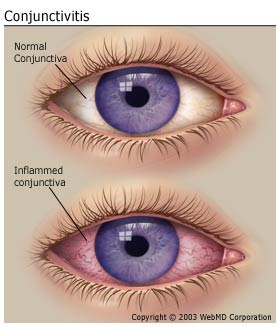Allergy
What is a Nasal Allergy?
The medical term rhinitis refers to a disorder often characterized
by symptoms including an itchy runny nose, sneezing, and nasal
congestion from a variety of causes. One of the most common
types of rhinitis is allergic rhinitis or "nasal allergy."
Before we discuss allergic rhinitis, one must better understand
what "allergy" is all about. Allergy is the opposite
of AIDS. Allergy symptoms are the result of too much immunity.
Your immune system produces antibodies to fight infection.
Your body is producing too much of an antibody known as E.
The allergy antibody E or (IgE) is made by your immune system
in response to an exposure to substances that we refer to
as Allergens. Allergens are usually environmentally stable
foreign substances like pollen protein that may induce allergic
reactions but only in predisposed individuals.
Why do allergic symptoms occur?
The allergic response starts when the immune system (which
is designed to protect the body from harmful material) mistakes
perfectly harmless materials (such as pollen and dust) for
potentially threatening "invaders." The defensive
process that follows starts with a group of specialized cells
known as mast cells.
Mast cells are located in various tissues in the body where
harmful materials can gain access - including the nose, eyes,
nasal mucosa, and lungs. Each mast cell contains chemicals,
such as histamine, that trigger the allergic response. When
histamine is released into your nose, you will sneeze and
have a runny nose. Histamine in the lungs will cause spasm
of the airways or wheezing. If histamine is released from
exploding mast cells into the skin, you may experience itching.
If an allergic reaction occurs all over the body, such as
with a severe life-threatening bee sting reaction, it is called
Anaphylaxis. As long as the body is not exposed to allergens,
these chemicals remain inside the mast cells, where they can
cause no harm. However, when a sensitive person is exposed
to an allergen, the mast cell membranes break down and the
chemicals escape (degranulation). Once the chemicals are released
from the cells, they go on to trigger the symptoms of allergic
rhinitis.
Allergic Conjunctivitis 
What is allergic conjunctivitis and what causes it?
A clear, thin membrane called the conjunctiva covers your
eyeball and the inside of your eyelids. If something irritates
this covering, your eyes may become red and swollen. Your
eyes also may itch or even hurt, and they may water. This
is called conjunctivitis.
When an allergen is the cause of the irritation, the condition
is called allergic conjunctivitis. Some common allergens include
pollen from trees, grass and ragweed; animal skin and secretions
such as saliva; perfumes and cosmetics; skin medicines; air
pollution and smoke. Other causes of conjunctivitis are viral
and bacterial infections.
Will allergic conjunctivitis damage my eyesight?
No. Allergic conjunctivitis is irritating and uncomfortable,
but it will not hurt your eyesight.
What can I do to avoid getting the above symptoms?
Try to identify and avoid the allergens that cause your symptoms.
For example, if you are allergic to pollen or mold, stay indoors
when pollen and mold levels are high. You can usually find
out when allergen levels are high from the weather report.
Keep your doors and windows closed and use an air conditioner
during the summer months.
How is allergic conjunctivitis treated?
Several types of eye drops are available to treat allergic
conjunctivitis. They can help relieve itchy, watery eyes and
may keep symptoms from returning. Eye drops may contain an
antihistamine, a decongestant, a nonsteroidal anti-inflammatory
drug (NSAID), or a mast-cell stabilizer. Some drops contain
a combination of these. Some eye drops require a prescription.
Antihistamine pills (which many people take for their allergies)
may also help. Your doctor will talk with you about which
treatment is right for you.
Do these treatments have side effects?
Many eye drops can cause burning and stinging at first when
you put them in, but this usually goes away in a few minutes.
It is important to remember that all medicines may potentially
cause side effects, so talk with your doctor before using
any medicine, including eye drops.
What else can I do to feel better?
It may help you to put a cold washcloth over your eyes for
relief. Lubricating eye drops (sometimes called artificial
tears) may also make your eyes feel better. You can buy these
drops without a prescription.
Can I wear my contact lenses?
It’s not a good idea to wear contacts while you have
allergic conjunctivitis, because you might get an eye infection.
Instead, wear your glasses until your eyes feel better.
Allergic to Dogs
Steps Can Be Taken to Reduce Dog Allergens
Many people will ignore both chronic allergy symptoms and
specific medical advice in order to keep the family dog.
Who Is Susceptible?
Allergies to dogs can strike anyone at any age. Most people
that suffer from dog allergies often have other mild or moderate
allergies to pollens or molds. There is a strong genetic correlation
in developing allergies, so if your parents have allergies
then you are likely to have them also.
Is Any Dog Safe?
No dog is considered non-allergenic because all dogs produce
dander, saliva, and urine which are the offending allergens.
Any dog who sheds skin, urinates, or licks has the potential
to become a problem for an allergic individual.
There are dogs that produce less dander, however. For instance,
dogs that shed their skin about every 21 days include poodles,
airedales, and schnauzers.
Symptoms
Dog allergens can produce nasal congestion, runny nose, itchy
nose, sneezing, itchy and watery eyes, coughing, a scratchy
sore throat, itchy skin rashes or hives, headaches, fatigue,
difficulties in breathing, and asthma.
Helpful Tips
Be sure to always wash your hands after each time you touch
or play with a dog. You may even want to shower and change
your clothing.
Dog allergens are small and sticky and can stay airborne
for a long time. They can adhere to walls, clothing, carpet,
furniture, and heating and cooling ducts. For this reason,
it is best to keep dogs away from the bedroom or any other
rooms you spend a lot of time.
Avoid using heavy carpets, large draperies, and upholstered
pieces that become collecting grounds for pet allergen. If
you have carpet, steam clean it several times a year. Wash
walls and baseboards also.
The use of HEPA room air cleaners and replacing central heating/cooling
system air filters frequently can help reduce the allergen
in the air. Dr. Adelglass recommends placing a screen made
of cheesecloth or other thin material over bedroom vents to
keep dander from circulating into the bedroom from the central
heating/cooling system.
Research has shown that if a dog is washed and brushed frequently
(not more than twice weekly), the airborne allergens are cut
drastically. This task should be done outside of the home.
Be sure the shampoo you use does not dry out the dog's skin
which may worsen the problem. Remember to also wash the dog's
bedding and toys.
Feed your dog a well-balanced diet which includes some natural
fat that helps reduce skin dryness and flaking.
Pollen Allergy
Each spring, summer, and fall, tiny particles are released
from trees, weeds, and grasses. These particles, known as
pollen, hitch rides on currents of air. Although their mission
is to fertilize parts of other plants, many never reach their
targets. Instead, they enter human noses and throats, triggering
a type of seasonal allergic rhinitis called pollen allergy,
which many people know as hay fever or rose fever (depending
on the season in which the symptoms occur). Of all the things
that can cause an allergy, pollen is one of the most widespread.
Many of the foods, drugs, or animals that cause allergies
can be avoided to a great extent; even insects and household
dust are escapable. Short of staying indoors when the pollen
count is high--and even that may not help--there is no easy
way to evade windborne pollen.
People with pollen allergies often develop sensitivities
to other troublemakers that are present all year, such as
dust mites. For these allergy sufferers, the "sneezin'
season" has no limit. Year-round airborne allergens cause
perennial allergic rhinitis, as distinguished from seasonal
allergic rhinitis.
What is pollen?
Plants produce microscopic round or oval pollen grains to
reproduce. In some species, the plant uses the pollen from
its own flowers to fertilize itself. Other types must be cross-pollinated;
that is, in order for fertilization to take place and seeds
to form, pollen must be transferred from the flower of one
plant to that of another plant of the same species. Insects
do this job for certain flowering plants, while other plants
rely on wind transport.
The types of pollen that most commonly cause allergic reactions
are produced by the plain-looking plants (trees, grasses,
and weeds) that do not have showy flowers. These plants manufacture
small, light, dry pollen granules that are custom-made for
wind transport. Samples of ragweed pollen have been collected
400 miles out at sea and 2 miles high in the air. Because
airborne pollen is carried for long distances, it does little
good to rid an area of an offending plant--the pollen can
drift in from many miles away. In addition, most allergenic
pollen comes from plants that produce it in huge quantities.
A single ragweed plant can generate a million grains of pollen
a day.
The chemical makeup of pollen is the basic factor that determines
whether it is likely to cause hay fever. For example, pine
tree pollen is produced in large amounts by a common tree,
which would make it a good candidate for causing allergy.
The chemical composition of pine pollen, however, appears
to make it less allergenic than other types. Because pine
pollen is heavy, it tends to fall straight down and does not
scatter. Therefore, it rarely reaches human noses.
Among North American plants, weeds are the most prolific
producers of allergenic pollen. Ragweed is the major culprit,
but others of importance are sagebrush, redroot pigweed, lamb's
quarters, Russian thistle (tumbleweed), and English plantain.
Grasses and trees, too, are important sources of allergenic
pollens. Although more than 1,000 species of grass grow in
North America, only a few produce highly allergenic pollen.
These include timothy grass, Kentucky bluegrass, Johnson grass,
Bermuda grass, redtop grass, orchard grass, and sweet vernal
grass. Trees that produce allergenic pollen include oak, ash,
elm, hickory, pecan, box elder, and mountain cedar.
It is common to hear people say that they are allergic to
colorful or scented flowers like roses. In fact, only florists,
gardeners, and others who have prolonged, close contact with
flowers are likely to become sensitized to pollen from these
plants. Most people have little contact with the large, heavy,
waxy pollen grains of many flowering plants because this type
of pollen is not carried by wind but by insects such as butterflies
and bees.
When do plants make pollen?
One of the most obvious features of pollen allergy is its
seasonal nature--people experience it symptoms only when the
pollen grains to which they are allergic are in the air. Each
plant has a pollinating period that is more or less the same
from year to year. Exactly when a plant starts to pollinate
seems to depend on the relative length of night and day--and
therefore on geographical location--rather than on the weather.
(On the other hand, weather conditions during pollination
can affect the amount of pollen produced and distributed in
a specific year.) Thus, the farther north you go, the later
the pollinating period and the later the allergy season.
A pollen count, which is familiar to many people from local
weather reports, is a measure of how much pollen is in the
air. This count represents the concentration of all the pollen
(or of one particular type, like ragweed) in the air in a
certain area at a specific time. It is expressed in grains
of pollen per square meter of air collected over 24 hours.
Pollen counts tend to be highest early in the morning on warm,
dry, breezy days and lowest during chilly, wet periods. Although
a pollen count is an approximate and fluctuating measure,
it is useful as a general guide for when it is advisable to
stay indoors and avoid contact with the pollen.
|
